|
1.
CENTRAL/ WEST AFRICA
Prices unchanged due to slow trading
There are no price changes to report during the first two
weeks of November. Trade has been very slow but
basically was in balance because production and stock
levels have been kept very low. The rainy season in Gabon
and Cameroon has been hampering logging and as a
consequence sawmill production was limited. China has
continued to buy, and while India has been less active,
trade was still being conducted. Prices for the favored
species have not moved, and Vietnam has proved to be a
more active buyer over the past few months for the lower
rated species. A few sales have been made to North
Africa but prices have been very high. Experts suggest that
some buyers may have been able to negotiate a slightly
lower price, while at the same time some producers may
be able to apply a price premium for higher quality or
special size specifications. These price differences were
unlikely to be more than a very few dollars up or down
and were not affecting the general stability of prices as
producers have stopped cutting any species for which
there is no interest from buyers.
In general, European importers have been reducing stocks
to a bare minimum. In the UK, companies in secondary
and tertiary processing such as windows and doors have
experienced marked slowdown in demand, and some small
and medium-sized businesses have been forced to close or
have reduced staff and production. One larger company
(Palgrave Brown) has gone into administration and
forecasts for 2009 for European housing and construction
business are not positive for West African exporters.
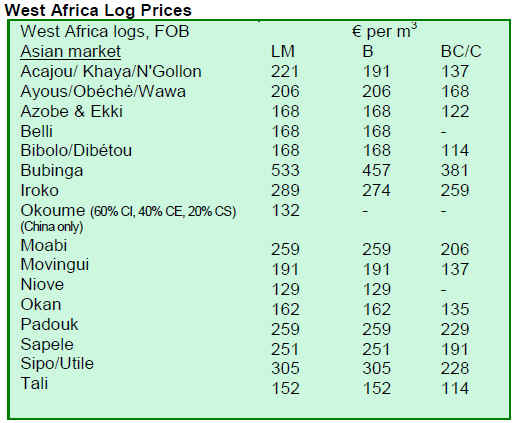
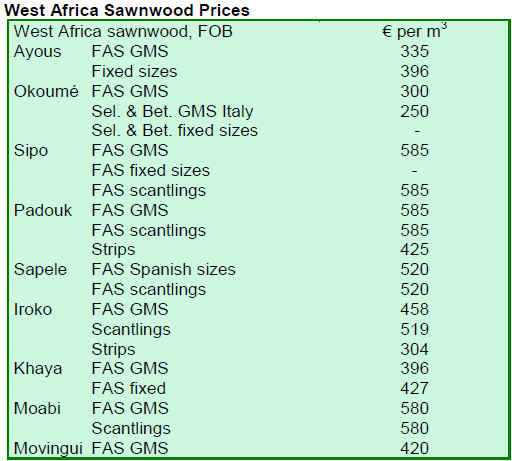
2. GHANA
TIDD export permits rise 7% in second quarter
The Timber Industry Development Division (TIDD) of the
Forestry Commission (FC) of Ghana vetted, processed and
issued 2,319 permits to exporters during the second
quarter of 2008 to ship various timber and wood products
through the Takoradi and Tema ports. This figure, which
includes overland exports to neighboring countries,
showed a 7% rise when compared to first quarter 2008
figures. A total of 1,022 export permits were issued for
kiln-dried and air-dried lumber registered the highest
number of export applications during the period. This
represented 44% of the total export permits issued. This
was followed by plywood (16.6%), mouldings (10.6%)
and sliced veneer (9.2%), with eleven other products
registering the remaining 19.5%.
Three hundred and thirty-two (332) export permits were
granted to 21 companies to export lumber, plywood and
blockboard by road to Burkina Faso, Nigeria, Niger,
Senegal, Benin and Togo. Exporting companies receiving
permits included Ghana Primewood Products Ltd (GAP),
John Bitar & Company Ltd (JCM), Naja David Veneer &
Plywood Company Ltd (NDVP) and Samartex Timber &
Plywood Company Ltd (SAX). The total volume and
value of permits issued for overland exports during the
second quarter of 2008 were 34,218 m³ and EUR8.5
million respectively, showing increases of 19.4% and
7.4% when compared to the previous quarter.
Edinam and wawa were the most exported air-dried levied
species in lumber form. Edinam represented 50.9% of the
total volume and value of exports during the second
quarter. Wawa represented 40.7% by volume and 24.8%
by value in the same period. During the period under
review, six export permits were issued in Takoradi to Best
Glow Wood Ltd. for the shipment of rubberwood lumber
to Malaysia. This involved a volume of 714 m³ at a total
value of EUR58,638. One export permit was also issued in
Tema to the Kugyampy Company Ltd. for the shipment of
powdered mahogany barks to China ostensibly for
medicinal purposes. This shipment was five tons valued at
EUR2,380.
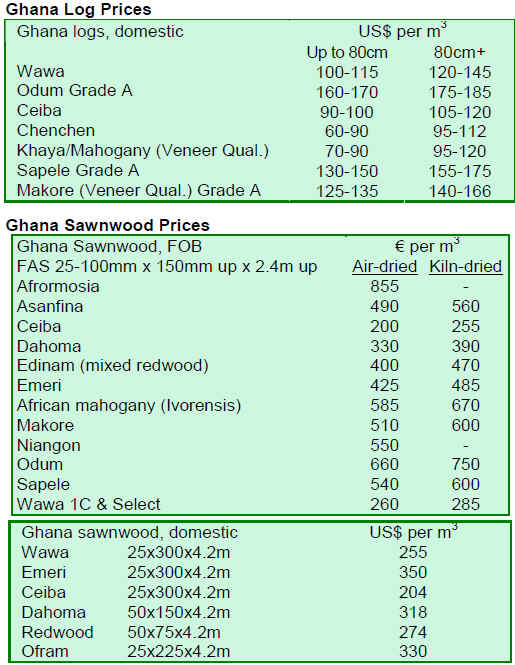
3.
MALAYSIA
Malaysia expects timber exports to slow in 2008
Malaysia¡¯s Deputy Plantation Industries and Commodities
Minister, Senator A. Kohilan Pillay, recently indicated that
Malaysia may see declines of timber and timber products
in 2008 due to the global economic slowdown. Bernama
reported on the minister¡¯s statement, which said that the
Malaysian industry¡¯s outlook would depend on demand
from major importers such as Japan, Europe and the US.
He recalled previous statements, which indicated that
Malaysia would need to expand into Middle East markets
to boost exports of timber and timber products and offset
drops in exports to traditional markets. He noted that in
2007, total exports of timber and timber products
amounted to RM22.65 billion. Wooden furniture
accounted for 29.3% of the total value of exports while
plywood earned 27.7% of total revenue. During the period
January to August 2008, exports of timber and timber
products amounted to RM14.9 billion, noted Kohilan. He
indicated that the timber sector was 5% of Malaysia¡¯s
GDP and provided over 300,000 jobs nationally. At the
same time, Kohilan noted that Malaysia was considering
reducing its dependence on foreign labor from about 2.16
million persons to about 1.53 million in 2015.
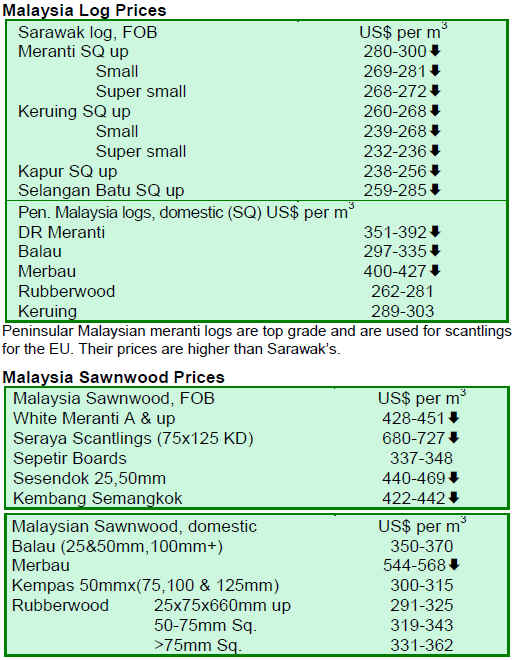
4.
INDONESIA
Prince Charles urges government to stay committed to
forest preservation
Antara News reported on Prince Charles¡¯ recent visit to
Indonesia, where he called on the government to maintain
its commitment to preserving its forests. During his tour of
the Indonesian Rain Forest Ecosystem Restoration Park in
Bungku village, the Prince asked accompanying
Indonesian Forestry Minister MS Kaban to support PT
Restorasi Ekosystem Indonesia¡¯s (REKI) initiative to
develop the park. Relatedly, Jambi Governor Nurdin has
already asked the Forestry Minister to issue a license for
REKI¡¯s ecosystem forest restoration project. Minister
Kaban has responded to the requests and said he has
issued a licence for the management of Jambi¡¯s forest
restoration areas of up to 101,000 hectares.
Bank Indonesia expects lower growth in fourth quarter
Bank Indonesia (BI) Deputy Governor Hartadi A.
Sarwono said that fourth quarter growth would be around
5.9%, lower than the 6.4% reported for in the third quarter,
indicated The Jakarta Post. Saying that the global
economic crisis was beginning to have an impact on the
Indonesian economy, Hartadi noted that he expected
overall growth in 2008 to be between 6.1 and 6.2%, one
tenth lower than growth in 2007. Nevertheless, he said that
the Indonesian economy would find ¡®a new equilibrium¡¯ in
the wake of the US recession and expected the full impact
of slowing exports and imports to be felt in 2009. He also
indicated that when the Indonesian rupiah adjusts to the
effects of the global economic slowdown, BI would be
developing appropriate policy responses to have an
¡®orderly adjustment¡¯.
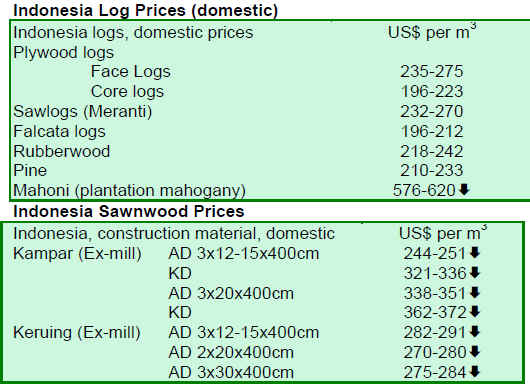
5.
MYANMAR
MTE announces price freeze on timber
The Myanmar Timber Enterprise (MTE) has announced
that the current list price, which has been in effect since
August 2008, will apply until 31 March 2009. The
announcement, made on 10 November 2008, also suggests
that the MTE may adjust the allowable felling and supply
to ease buyers¡¯ current problems. Buyers are expecting to
see some quantity adjustments in the coming tenders.
Major importers, particularly India, China, Thailand and
Pakistan, have been facing difficulties with supply and
prices. It is expected that buyers and sellers will have to
make some concessions to address the current market
situation.
Reports from Myanmar indicate that the current economic
crisis has been causing some uncertainty among timber
dealers. India, which is a major consumer of teak, was said
to have fallen behind in purchases and shipments. Indian
buyers noted exchange rate problems and credit facilities
as some of the factors the factors affecting their purchases
and shipments. As it has been reported, the negative
economic effects of the credit crunch are being felt in
India as well.
The tender prices fell during the past few months.
Earnings from tender sales are less than 16% of MTE¡¯s
total annual exports. More than 80% of revenue for MTE
has been from direct sales (with fixed prices) during the
past three years.
Some analysts feel that selling higher quantities of teak to
meet annual revenue targets could backfire on both buyers
and sellers. Prior to the price freeze, some dealers had
argued that a sharp reduction in prices could have affected
buyers with heavy stock. Similar recommendations were
made in the past and often proved wrong, as teak from
natural forests is only a negligible fraction of the world¡¯s
timber trade. As such, demand always seems to be good.
Analysts were usually not able to consider all the variables
involved in predicting the effect of lowering prices on
demand.
November is the end of the felling season and the start of
the trucking season in Myanmar. Timber has started to
come down to Yangon depots in trucks and barges. As a
result, analysts suggest it is not practical to reduce supply
at this point in time, in order to recoup expenses.
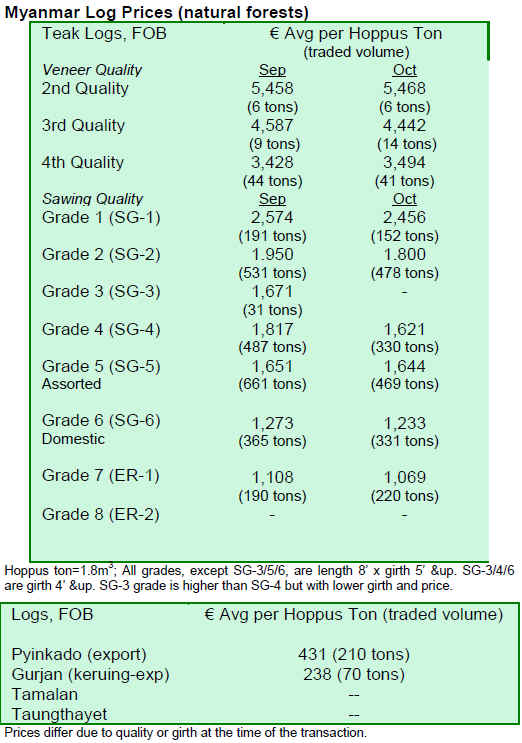
6.
BRAZIL
Amazon Fund aims to raise USD21 billion by 2021
Despite the global economic crisis, countries and private
companies continue to make donations to the Amazon
Fund, noted Portal Cultura. The expectation is that by
2021, Brazil would raise about USD21 billion for projects
to combat deforestation in the Amazon. In addition to
funds already donated by Norway, Japan, South Korea and
Sweden have shown interest in making donations to the
Fund.
At the first meeting of an oversight committee for the
Amazon Fund, guidelines and priorities for the fund were
presented. Participants decided that projects meeting more
than one objective of the Fund would have priority. The
committee is composed of nine representatives from the
federal and state governments and six members of civil
society, to be appointed by the Brazilian Development
Bank (BNDES). The donors of the Amazon Fund are not
entitled to be members of the committee in order to ensure
Brazil¡¯s sovereignty over the management and protection
of the Amazon.
Projects to be supported by the Amazon Fund are expected
to include the following topics: management of public
forests and protected areas; environmental control,
monitoring and surveillance; sustainable forest
management; ecologic-economic zoning; land use and
land regulation; conservation of biodiversity and
sustainable biodiversity use; restoration of deforested
areas; and payment for environmental services. These
projects must be linked with the strategies of the Action
Plan for Prevention and Control of Deforestation in the
Amazon and with the goals of the Sustainable Amazon
Plan.
The Brazilian Minister of the Environment welcomes
payment for environmental services as an alternative
means to address sustainable development. According to
the Minister, there are aspects that cannot be resolved by
the police or IBAMA. Therefore, alternatives to
sustainable development are needed. The objective of the
Amazon Fund is to finance sustainable forest-based
activities in order to curb illegal activities.
Brazilian timber industry on alert
Interact Comunicaçao Empresarial reported that the lack
of credit for exports, the fluctuation of the US dollar and
instability of international markets has placed the Brazilian
forest sector on alert. The sector represents 3.4% of the
Gross Domestic Product and generates more than 8.6
million jobs. Exporters are hesitant to close deals due to a
strong daily fluctuation of the Brazilian real. According to
reports from Brazil, foreign buyers have demanded
discounts on price to compensate the expected variation in
the exchange rate.
The mechanically-processed timber products industry has
faced difficulties since 2005, when rising costs caused
exports to fall and competitors such as China emerged in
the international market. This had a negative effect on
Brazil¡¯s market, including a drop in job creation.
Parana, a traditional exporting state of pine plywood,
recorded a 4.73% drop in exports in July 2008 when
compared to the same period of 2007, according to the
Federation of Industries of the State of Parana (FIEP).
With domestic housing construction having grown in the
past two years, analysts suggest that companies producing
wood finishing for civil construction have and in the future
will likely see significant sales in the Brazilian market. In
addition, the global economic crisis is not expected to
affect low-income housing construction, as it relies on
special governmental credit lines.
Brazilian furniture sector shares concerns about
global economic crisis
Agencia Sebrae de Not¨ªcias/Abim¨®vel reported on the
concerns of the Brazilian furniture sector about the effects
of the global economic crisis. In recent weeks, prices of
raw materials for furniture production have been
increasing and other prices of products essential to the
sector, such as paints and varnishes, have been rising or
were expected to rise in the coming weeks.
The global economic slowdown is a concern for the
furniture sector because of the uncertainty for Brazilian
furniture producers and the impact of the crisis on the
production chain, which affects 16,500 companies.
Most of the sector is composed of micro and small-sized
companies. The sector generates 232,000 direct and
460,000 indirect jobs in Brazil. In recent years, furniture
producers have made efforts to work with certified wood
from management plans authorized by the Brazilian
Institute for the Environment and Renewable Natural
Resources (IBAMA) and other environmental agencies.
The forecast of the Brazilian Association of Furniture
Companies (ABIMOVEL) for 2008 suggests a 10%
increase in sales to the domestic market. Analysts expect
an increase of 5% in exports this year. The main importer
of Brazilian furniture is the US, responsible for more than
half of furniture exports. In 2008, sales to the US have so
far decreased around 30%.
The majority of furniture production is oriented to the
domestic market, but in the past four months, sales have
been slowing down. Sales in the first quarter of 2008 were
favorable in the domestic market, but in the second quarter
they began to drop, both for high-cost and popular
furniture.

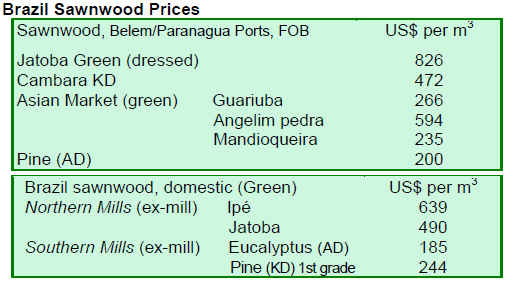
7.
PERU
Peru exchanges over USD25 million in debt for forest
protection
The US Department of the Treasury has recently
announced an over USD25 million debt-for-nature swap
with the Government of Peru under the Tropical Forest
Conservation Act. The initiative builds on previous debtfor-
nature agreements with Peru and aims to dedicate the
new funds to finance projects for the conservation,
protection and restoration of Peru¡¯s forests over a seven
year period. The new agreement is the fourteenth such
agreement under the Tropical Forest Conservation Act,
which is expected to raise a total amount of USD188
million to protect tropical forests.
Peru and Brazil dispute over Amazon logging
Various news reports have detailed recent disputes
between Brazil and Peru over uprooted Indian tribes that
have been forced to migrate as a result of logging in the
Amazon Forest. Reuters noted the inter-tribal conflicts
may drag both Brazil and Peru into disputes over their
responsibilities in the events. Two human rights
organizations working in the area, Survival International
and the Indigenous Committee for the Protection of
Uncontacted Tribes those in Initial Contact in Amazonia,
the Chaco and Eastern Paraguay (CIPIACI), have said the
Peruvian authorities have not been addressing the issue,
especially in the Ucayali region. Peru has denied the
claims over its responsibility in the conflicts. Nevertheless,
deforestation in Peru is recognized as a problem, even
though deforestation continues both in Brazil and Peru.
National Wood Convention draws Mexican businesses
The Fourth National Wood Convention, jointly organized
by ADEX and the Regional Government of Loreto and
supported by the ITTO, was held at end September 2008
and drew over 300 participants from businesses,
governments, traders and academic experts. Mexican
businesses took a keen interest in the event, with the
Mexican Import and Export Association of Forest
Products (IMEXFOR) signing a Memorandum of
Understanding with the Exporters¡¯ Association of Peru
(ADEX) and the Regional Government of Loreto to
strengthen cooperation between the two countries. The
National Wood Convention also hosted 5 other side events
about forest management and development and the
international wood market.
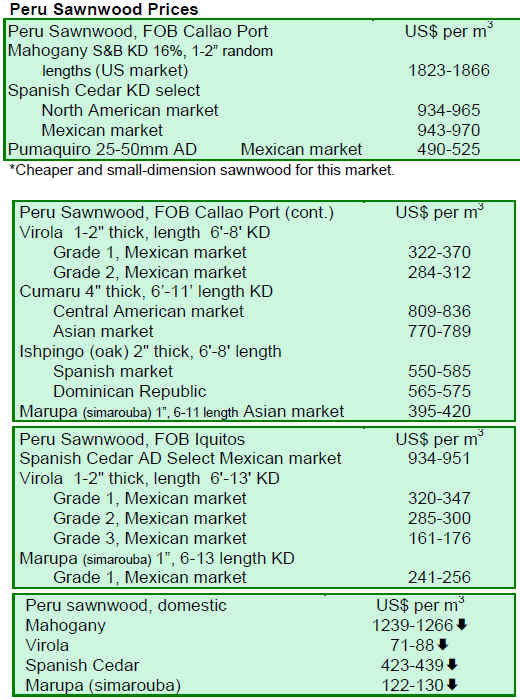
8. BOLIVIA

9. MEXICO
Forest certification on the rise in Mexico
In Mexico, the Federal Government through the National
Forest Agency (CONAFOR) grants economic supports to
pay for certification. The ProTree 2008 program, for
example, includes a specific subcategory of support for
Forest Certification. The objective of certification is to
ensure that forests are managed according to a series of
principles for environmental conservation, social justice
and economic viability, when considering standards of
international recognition.
Durango has a large amount of certified forest in Mexico,
under the Rainforest Alliance Mexico¡¯s SmartWood
program. Enrique Vega Fernandez of Rainforest Alliance
recently explained the processes of certification and chain
of custody. He noted that the processes involved, from
evaluation to certification, could take about three months
on average (up to 6 months in extreme cases) and depends
on the following: size of the operation; traveling distance
to the area; complexity; and existence of serious conflicts.
He explained that the certificate granted for forest
management or chain of custody remains active for five
years, but annual audits are conducted to determine
adherence to management standards. Where remedial
actions are not taken to address deficiencies in forest
management, a suspension or cancellation of the
certificate is possible. In Mexico, the Foundation for
Forest Life A.C. (Fundaci¨®n Vida para el Bosque A.C.)
has carried out initiatives for forest certification programs
and Rainforest Alliance Mexico, Alliance for Forests A.C.
are the two associations accredited by the Forest
Stewardship Council to conduct evaluations.
10.
GUYANA
Plywood exports recover in third quarter
Export volumes of plywood in the third quarter of 2008
have recovered from the first two quarters, showing
progressively greater export volumes. Plywood accounted
for as much as 41% of all wood exported. As of end
September 2008, plywood exports by volume were 9%
greater than that of the previous quarter and 14% over the
first quarter¡¯s total. The leading market for this product
continues to be the US, consuming 54.4% of all plywood
exported from January to September 2008. Consumption
of Guyana¡¯s plywood in this market increased in the third
quarter by 31.4% and 16.4% over its first and second
quarter consumption, respectively.
Other improvements exports were recorded for logs, with
third quarter volumes accounting for 34% of all log
exports, ending September 2008. This was attributable to
the much larger increase in demand for Guyana¡¯s logs
from India. Log exports to India in the third quarter
accounted for 53.8% of total export volume for the three
quarters. Total export of logs are, however, still lower than
2007 by both value and volume.
Moreover, loans and cash advances to businesses in the
forest sector have shown marked increases in January to
August 2008 when compared to same period of 2007. A
robust 14.8% increase in investment recorded in the sector
reflects a continued interest in Guyana¡¯s timber products
both locally and internationally. The increase in loans and
advances by commercial banks to the sector were reported
in documents from the Central Bank of Guyana.
Chainsaw milling project addresses community forest
work
In May 2008, Guyana commenced work on a project that
focuses on chainsaw milling in Guyana and Ghana to
address this area at the local community level. This work
is being undertaken as part of a project financed by the
European Union and implemented by Tropenbos
International (TBI). The Ghana Forestry Commission and
the Forestry Research Institute of Ghana are the local
partners on the ground in Ghana and Iwokrama
International Centre for Rainforest Conservation and the
Forestry Training Centre Inc. (FTCI) are the implementing
partners in Guyana.
The project¡¯s activities include an overview of chainsaw
milling practices through research at national level,
dialogue at the local, regional and international levels and
capacity building for sustainable forest management at the
community level. On a wider scale, the project will
contribute to the: reduction of poverty and promotion of
livelihoods in forest dependent communities; reduction of
the illegal logging; and the conservation and sustainable
management of tropical forests.
To date, there has been much progress in project activities,
including the completion of draft reports on three research
themes on chainsaw logging. These are: an assessment of
the impacts of chainsaw milling in Guyana; the
institutional policy and legal framework and drivers of
chainsaw milling in Guyana; and a diagnosis of chainsaw
milling in Guyana.
At this early stage, there have been several exchanges
between Guyana and Ghana on the substance of the
project, with a workshop hosted in Ghana in May¨CJune
2008, to address, among other areas, techniques of
implementing the landscape approach and multistakeholder
dialogues. Another meeting recently hosted in
Guyana in November 2008, which was attended by
Representatives of Tropenbos International, Ghana¡¯s
Forestry Commission and various participants from
Guyana. It is hoped that this project will result in the
creation of a higher level of understanding and stakeholder
dialogue in the area of chainsaw milling in Guyana.
GFC holds Forestry Open Day
On 27 October 2008, the Guyana Forestry Commission
held an open day tour of the Forestry Training Center
Inc¡¯s (FTCI) location at Manaka on the Essequibo River.
The tour was designed for special invitees, including the
Minister of Agriculture with responsibility for forestry,
Mr. Robert Persaud, the media and other key stakeholders,
to gain a first hand look at what is being done to develop
sustainable forest management through Reduced Impact
Logging (RIL) practices and other schemes.
Forestry Training Centre Inc. personnel gave a practical
demonstration of RIL at work, while outlining some
aspects of other training modules, including the operation
of forestry equipment and skid trail planning.
The session was successful in the sharing of experiences
with key stakeholders of the forest sector, the aspects of
training offered by the Center. Many persons have taken
advantage of these sessions, which has led FTCI to expand
training facilities to the regional level.

|